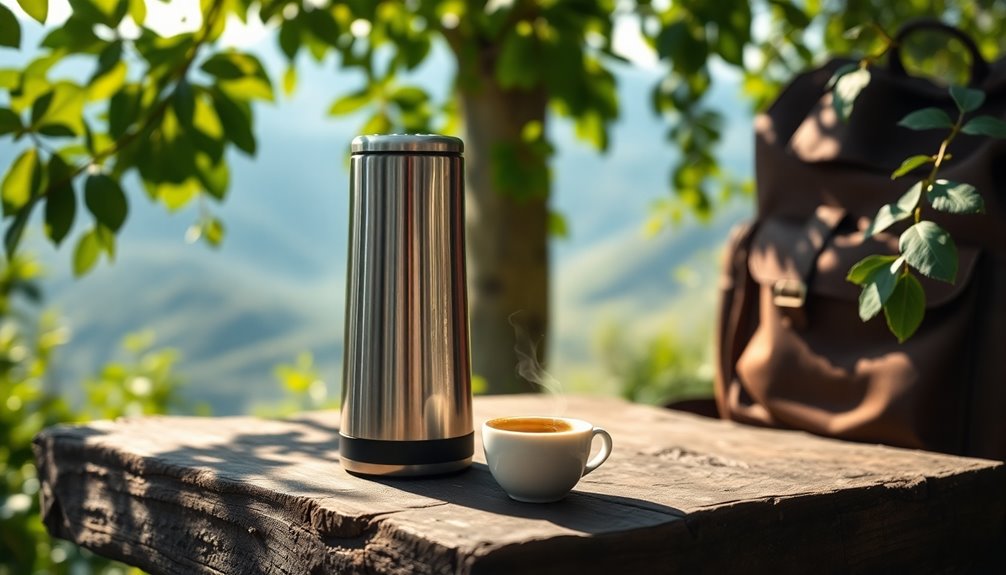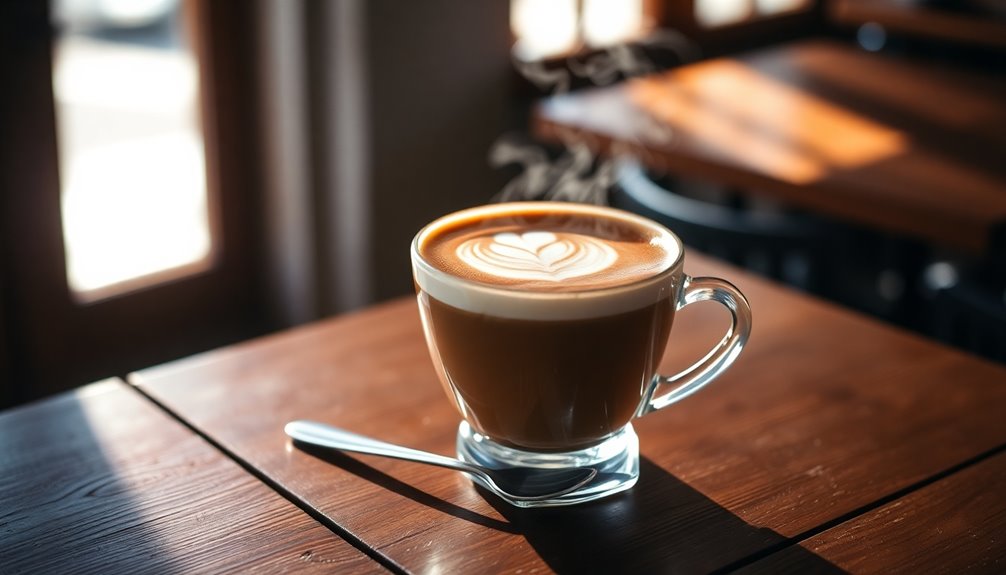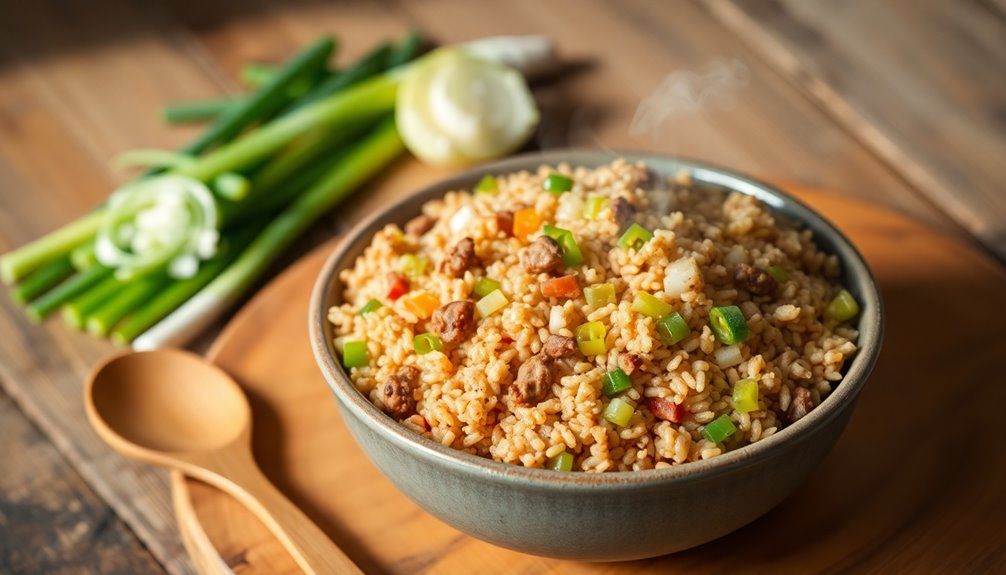For espresso lovers, Italian coffee bean brands like Lavazza, Illy, and Segafredo Zanetti offer incredible options. Lavazza's smooth blends and Illy's high-quality Arabica beans are particularly popular. Don't miss Kimbo, known for its Neapolitan roasting style, or Pellini's single-origin gems. When you explore espresso varieties, try Ristretto for a more concentrated kick or a traditional Lungo for a milder experience. Each brand brings distinct flavor profiles, like chocolate or nutty tones, ensuring you'll find your perfect brew. Stick around to uncover even more tips and tricks for crafting the ideal espresso at home.
Key Takeaways
- Lavazza offers a range of quality blends, known for their velvety smooth profile, ideal for traditional Italian espresso lovers.
- Illy specializes in high-quality Arabica beans, delivering a refined and consistent flavor that appeals to espresso enthusiasts.
- Segafredo Zanetti provides diverse blends, making it a popular choice for coffee drinkers seeking variety in their espresso experience.
- Kimbo is recognized for its traditional Neapolitan roasting style, creating robust and rich flavors perfect for authentic espresso.
- Pellini focuses on high-quality, single-origin beans, offering unique taste profiles that enhance the espresso experience for connoisseurs.
Top Italian Coffee Brands
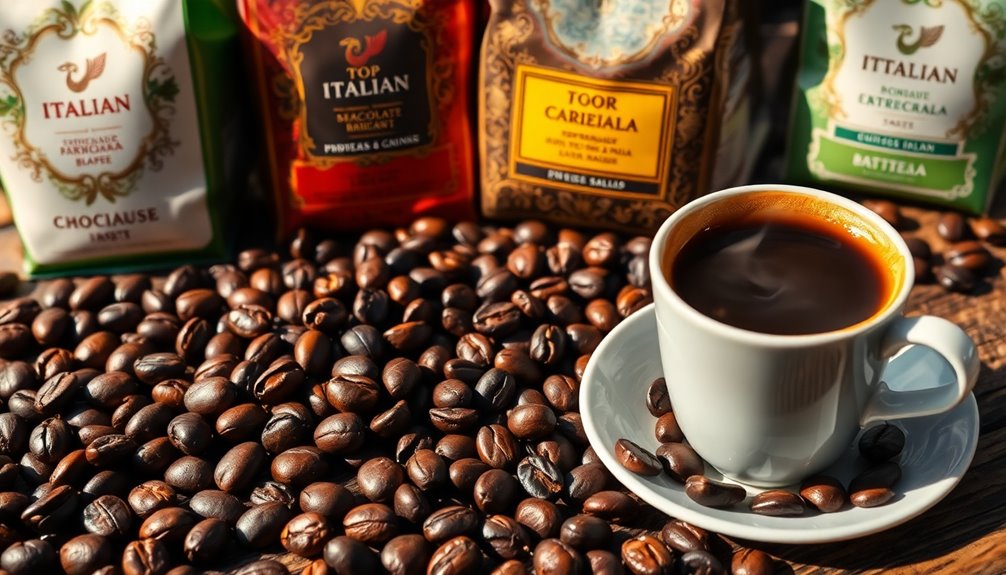
When it comes to Italian coffee brands, five stand out for their exceptional quality and global reach.
Lavazza, an iconic name, offers premium blends with a velvety smooth profile.
Illy, renowned worldwide, remains family-owned and focuses on high-quality Arabica beans from various regions.
Segafredo Zanetti commands a significant presence in over 100 countries, providing diverse blends to satisfy different tastes.
Kimbo, known for its Neapolitan roasting style, is rapidly expanding and gaining popularity in cities like London and Paris.
Finally, Caffè Vergnano boasts a legacy of over 130 years, sourcing top beans and maintaining a strong presence across Italy and beyond.
Each brand showcases unique attributes, making them favorites among espresso lovers.
Popular Espresso Varieties

Espresso lovers can explore a variety of popular espresso types that highlight Italy's rich coffee culture. Traditional Italian espresso, known for its strong, concentrated flavor, is made from finely ground coffee beans and hot water, typically served in small cups.
You'll also find espresso blends, crafted by combining beans from different regions to ensure consistent quality and flavor. Each region in Italy boasts its unique roasting and blending traditions, resulting in distinct flavor profiles, like chocolate or hazelnut notes.
For instance, Antica Tostatura Triestina is known for its post-roasting blend technique. No matter the variety, mastering the grind and using proper equipment is essential for achieving that authentic Italian espresso experience you crave.
Roast Levels Explained

Understanding roast levels is essential for any coffee enthusiast who wants to appreciate the nuances of espresso. The roasting process transforms green beans, starting at 75°F, to various levels. Light roasts, at around 415°F, showcase a light brown color with fruity and floral notes, while medium roasts, achieved around 435°F, offer a balanced taste and smooth body. Dark roasts, like the Italian roast at 474°F, exhibit a very dark color with a bittersweet and thin-bodied profile. Each level impacts flavor and acidity, with lighter roasts being more acidic and darker ones being richer and less acidic. Knowing these differences helps you select the perfect espresso that suits your palate and brewing preferences, as caffeine content can vary slightly between roast levels.
Bean Origins and Blends
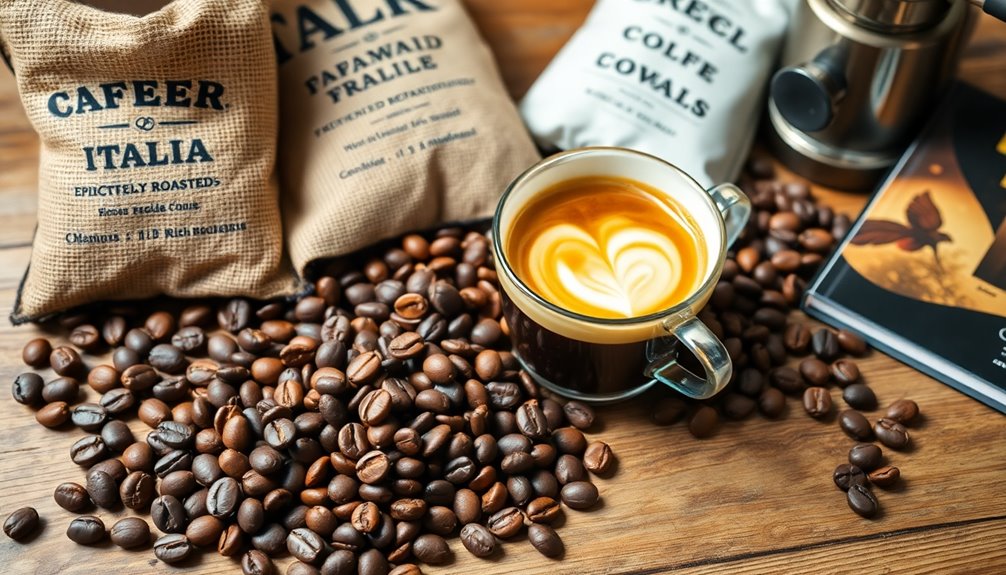
Exploring the origins of coffee beans reveals a rich tapestry of flavors and characteristics that define your espresso experience.
You'll find blends like CaffeUmbria's BIZZARRI, which combines beans from Peru, El Salvador, and Uganda, offering unique notes.
Meanwhile, the GUSTO CREMA Blend features Brazilian and Colombian beans, known for their creamy body and milk chocolate hints.
If you're after a diverse experience, try the GRIFO Blend, which mixes seven origins, including hints of dried mango and anise.
TERRA SANA stands out with its Organic and Fair Trade certification, sourced from smallholder farmers across Peru, Mexico, and East Timor.
Each blend showcases the beauty of multi-origin sourcing, ensuring a vibrant cup every time.
Flavor Profiles to Explore

The rich origins of coffee beans set the stage for the diverse flavor profiles you'll encounter in Italian espresso.
In Northern Italy, expect a lighter, smoother cup with a delicate balance of Arabica beans, often leaving a subtle sweet aftertaste.
Southern Italy, on the other hand, serves up bold, intense espressos, typically using darker roasts and Robusta beans for a thicker crema and stronger bitterness.
Traditional profiles range from bold and rich, featuring complex flavors, to balanced and smooth blends of fruity and nutty notes.
Brands like Kimbo and Segafredo Zanetti showcase these characteristics, while artisanal options like Ecco Caffè and Carluccio's Roma Blend offer unique tastes that cater to your espresso cravings.
Brewing Techniques for Espresso

To brew the perfect espresso, you need to focus on several key techniques that ensure a rich and satisfying shot.
Start by warming up your espresso machine for 15-30 minutes and using cool, filtered water in the reservoir.
Weigh out 18 grams of coffee beans for a double shot, grinding them to a fine consistency.
Add the grounds to a clean portafilter and tamp them evenly with firm pressure.
Lock the portafilter into the machine and start the shot, timing for 25-30 seconds.
Look for a steady stream resembling warm honey and check for a rich crema on top.
Finally, evaluate the taste to ensure it's strong yet balanced, adjusting the grind size or extraction time as needed. Additionally, maintaining the brewing temperature within the optimal range of 195°F to 205°F will greatly enhance flavor extraction.
Grinding Methods for Espresso

Achieving the perfect espresso starts with selecting the right grinding methods, as they play a crucial role in the overall flavor and extraction. Burr grinders are your best bet for a consistent fine grind, while blade grinders should be avoided due to their uneven results. Aim for a fine grind, similar to fine table salt, and adjust based on your machine and taste preferences. Always grind just before brewing for maximum freshness. Measure about 18-20 grams for a double shot and check that the grind feels slightly gritty but not powdery. Grinding increases surface area exposure enhances flavor extraction, making your espresso experience even more delightful. Experiment with different settings until you find the ideal grind for your espresso machine, and remember that regular maintenance keeps your grinder performing at its best.
Quality Control Practices

While selecting quality coffee beans is crucial, implementing stringent quality control practices ensures that every cup of espresso meets your expectations.
Suppliers maintain consistency over decades, allowing you to enjoy a reliable flavor profile. Each batch is meticulously identified by brand and lot, fostering long-term relationships that uphold quality standards.
Upon arrival in Italy, green coffee undergoes health and safety checks, including assessments for pesticides to comply with EU regulations.
Organoleptic tests and chemical analyses verify that each bean meets the desired standards. Companies also obtain UNI EN ISO 9001:2015 certification, ensuring they consistently meet customer expectations.
Sustainable Sourcing in Coffee

Quality control practices set the stage for another vital aspect of coffee enjoyment: sustainable sourcing.
When you choose coffee sourced sustainably, you're supporting the preservation of ecosystems and wildlife habitats.
Farms that utilize organic methods and shade-grown cultivation help protect biodiversity and minimize deforestation.
Additionally, these sustainable practices conserve water and reduce pollution through efficient irrigation and lower chemical inputs.
Notable Espresso Recipes

Espresso lovers are in for a treat with a variety of delightful recipes that cater to every palate.
Start with the classic Americano, where you dilute a shot of espresso with hot water for a milder flavor. If you crave something indulgent, try Espresso Con Panna, topped with whipped cream.
For a bold experience, go for a Doppio, offering a double shot of rich espresso. Milk-based fans will enjoy a creamy cappuccino or a sweet mocha.
For a unique twist, mix espresso with chocolate in a Marocchino or enjoy a refreshing Café con Hielo over ice.
Each recipe showcases espresso's versatility, ensuring you find a favorite to satisfy your coffee cravings!
Frequently Asked Questions
What Is the Best Storage Method for Espresso Beans?
To keep your espresso beans fresh, store them in a cool, dark, and dry place.
Use airtight, opaque containers to prevent air and light exposure, which can compromise flavor.
Avoid the refrigerator; instead, consider freezing them immediately after roasting in a chest-style freezer if you need long-term storage.
Just remember to thaw them overnight before use and only do this once to maintain quality.
Enjoy your espresso at its best!
How Long Do Roasted Coffee Beans Stay Fresh?
Roasted coffee beans stay fresh for about a year if you keep them sealed in an air-tight container.
Once you open the bag, it's best to use the beans within a week for the best flavor. You can stretch that to three weeks, but don't expect the same aroma and taste.
Lighter roasts tend to last a bit longer than darker ones, so consider your roast choice when storing.
Can I Mix Different Brands for My Espresso?
Yes, you can mix different brands for your espresso!
Just remember that balancing their unique flavors can be tricky. Start with a solid base coffee, then add complementary ones to enhance complexity.
Watch out for roast levels, as over-roasting might mask delicate notes. Aim for uniform grind consistency, and ensure freshness by storing them properly.
Experiment with ratios until you find a blend that brings out the best in each coffee you choose!
What Equipment Do I Need for Making Espresso at Home?
To make espresso at home, you'll need a few essential pieces of equipment.
Start with an espresso machine—consider a semi-automatic for control or a super automatic for convenience.
Pair it with a quality burr grinder for the best grind consistency.
Don't forget a portafilter, tamper, and milk pitcher if you enjoy lattes or cappuccinos.
A scale can help you measure ingredients accurately, ensuring a perfect brew every time.
How Do I Know if My Espresso Has Extracted Correctly?
To know if your espresso's extracted correctly, look for a thick crema on top.
The color should be dark brown, and the volume should be about 1-2 ounces, achieved in 20-30 seconds.
You should notice a smooth, steady flow without dripping.
Taste-wise, it should balance sweetness, low to medium acidity, and a hint of bitterness.
If all these elements align, you've likely nailed the extraction!
Conclusion
In your quest for the perfect espresso, exploring top Italian coffee brands and varieties is essential. Dive into different roast levels and flavor profiles to find what suits your palate. Don’t forget to consider the origins and blends of the beans you choose. By understanding grinding methods and prioritizing quality control and sustainable sourcing, you’ll elevate your coffee experience. Enjoy experimenting with notable espresso recipes, and savor every rich, bold sip you create! When seeking to create the perfect espresso at home, investing in authentic Italian espresso machines can make all the difference. These machines are designed to extract the rich flavors and aromas of the coffee beans, ensuring a true Italian coffee experience. By embracing the traditions and craftsmanship of Italian coffee culture, you can elevate your espresso-making skills and enjoy a truly authentic and satisfying cup of coffee.

